Lexus GX460 2020 Owner's Manual / LEXUS 2020 GX460 OWNER'S MANUAL (OM60R27U)
Manufacturer: LEXUS, Model Year: 2020, Model line: GX460, Model: Lexus GX460 2020Pages: 620, PDF Size: 12.41 MB
Page 461 of 620

GX460_OM_OM60R27U_(U)
4616-3. Do-it-yourself maintenance
6
Maintenance and care
■Before recharging
When recharging, the battery produces hydrogen gas which is flammable and explosive.
Therefore, observe the following before recharging:
●If recharging with the battery installed on the vehicle, be sure to disconnect the ground
cable.
●Make sure the power switch on the charger is off when connecting and disconnecting
the charger cables to the battery.
■After recharging/reconnecting the battery
The engine may not start. Follow the procedure below to initialize the system.
Shift the shift lever to P
Open and close any of the doors.
Restart the engine.
●Unlocking the doors using the smart access system with push-button start may not be
possible immediately after reconnecting the battery. If this happens, use the wireless
remote control or the mechanical key to lock/unlock the doors.
●Start the engine with the engine switch in ACCESSORY mode. The engine may not
start with the engine switch turned off. However, the engine will operate normally from
the second attempt.
●The engine switch mode is recorded by the vehicle. If the battery is reconnected, the
vehicle will return the engine switch mode to the status it was in before the battery was
disconnected. Make sure to turn off the engine before disconnect the battery. Take
extra care when connecting the battery if the engine switch mode prior to discharge is
unknown.
If the system will not start even after mult iple attempts, contact your Lexus dealer.
WARNING
■Chemicals in the battery
Batteries contain poisonous and corrosive sulfuric acid and may produce hydrogen
gas which is flammable and explosive. To reduce the risk of death or serious injury, take
the following precautions while working on or near battery:
●Do not cause sparks by touching the battery terminals with tools.
●Do not smoke or light a match near the battery.
●Avoid contact with eyes, skin and clothes.
●Never inhale or swallow electrolyte.
●Wear protective safety glasses when working near the battery.
●Keep children away from the battery.
■Where to safely charge the battery
Always charge the battery in an open area . Do not charge the battery in a garage or
closed room where there is not sufficient ventilation.
1
2
3
Page 462 of 620

462
GX460_OM_OM60R27U_(U)6-3. Do-it-yourself maintenance
WARNING
■How to recharge the battery
Only perform a slow charge (5A or less).
The battery may explode if charged at a
quicker rate.
■Emergency measures regarding electrolyte
●If electrolyte gets in your eyes
Flush your eyes with clean water for at least 15 minutes and get immediate medical
attention. If possible, continue to apply water with a sponge or cloth while traveling to
the nearest medical facility.
●If electrolyte gets on your skin
Wash the affected area thoroughly. If you fe el pain or burning, get medical attention
immediately.
●If electrolyte gets on your clothes
It can soak through clothing on to your s kin. Immediately take off the clothing and fol-
low the procedure above if necessary.
●If you accidentally swallow electrolyte
Drink a large quantity of water or milk. Get emergenc y medical attention immedi-
ately.
NOTICE
■When recharging the battery
Never recharge the battery while the engine is running. Also, be sure all accessories
are turned off.
Page 463 of 620
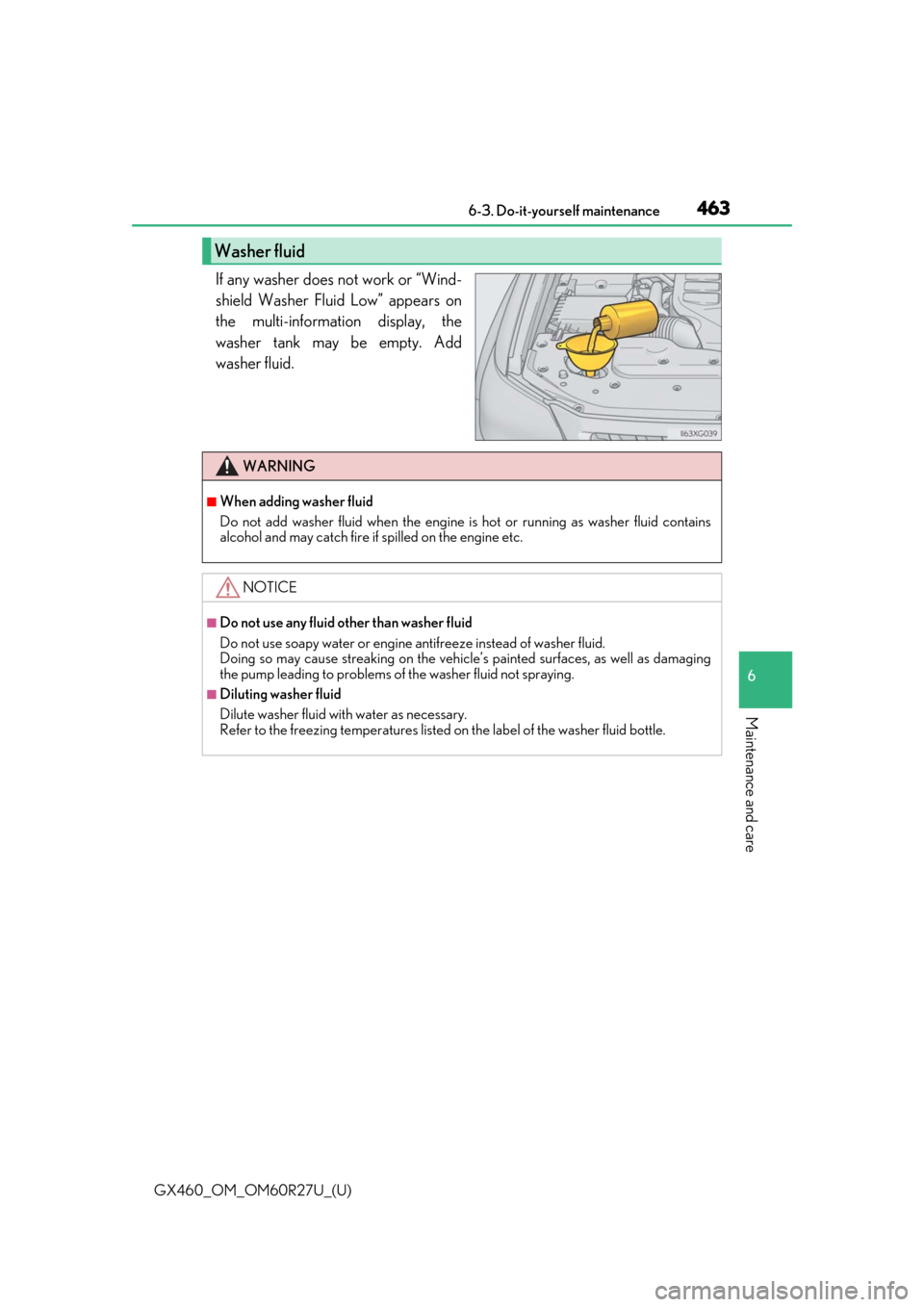
GX460_OM_OM60R27U_(U)
4636-3. Do-it-yourself maintenance
6
Maintenance and care
If any washer does not work or “Wind-
shield Washer Fluid Low” appears on
the multi-information display, the
washer tank may be empty. Add
washer fluid.
Washer fluid
WARNING
■When adding washer fluid
Do not add washer fluid when the engine is hot or running as washer fluid contains
alcohol and may catch fire if spilled on the engine etc.
NOTICE
■Do not use any fluid other than washer fluid
Do not use soapy water or engine antifreeze instead of washer fluid.
Doing so may cause streaking on the vehicle’s painted surfaces, as well as damaging
the pump leading to problems of the washer fluid not spraying.
■Diluting washer fluid
Dilute washer fluid with water as necessary.
Refer to the freezing temperatures listed on the label of the washer fluid bottle.
Page 464 of 620
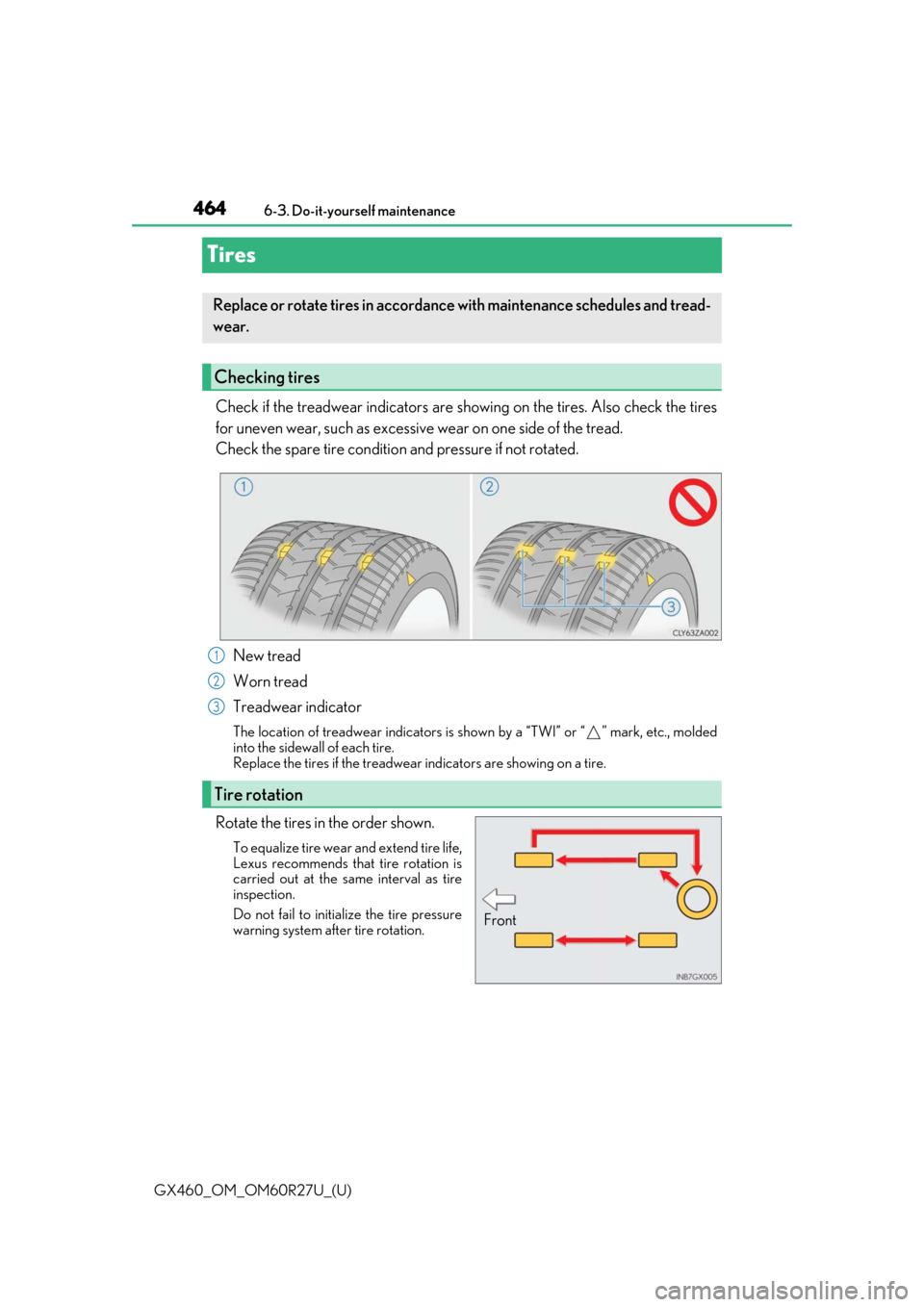
464
GX460_OM_OM60R27U_(U)6-3. Do-it-yourself maintenance
Tires
Check if the treadwear indicators are showing on the tires. Also check the tires
for uneven wear, such as excessive
wear on one side of the tread.
Check the spare tire condition and pressure if not rotated.
New tread
Worn tread
Treadwear indicator
The location of treadwear indicators is shown by a “TWI” or “ ” mark, etc., molded
into the sidewall of each tire.
Replace the tires if the treadwear indicators are showing on a tire.
Rotate the tires in the order shown.
To equalize tire wear and extend tire life,
Lexus recommends that tire rotation is
carried out at the same interval as tire
inspection.
Do not fail to initialize the tire pressure
warning system after tire rotation.
Replace or rotate tires in accordance with maintenance schedules and tread-
wear.
Checking tires
Tire rotation
1
2
3
Front
Page 465 of 620
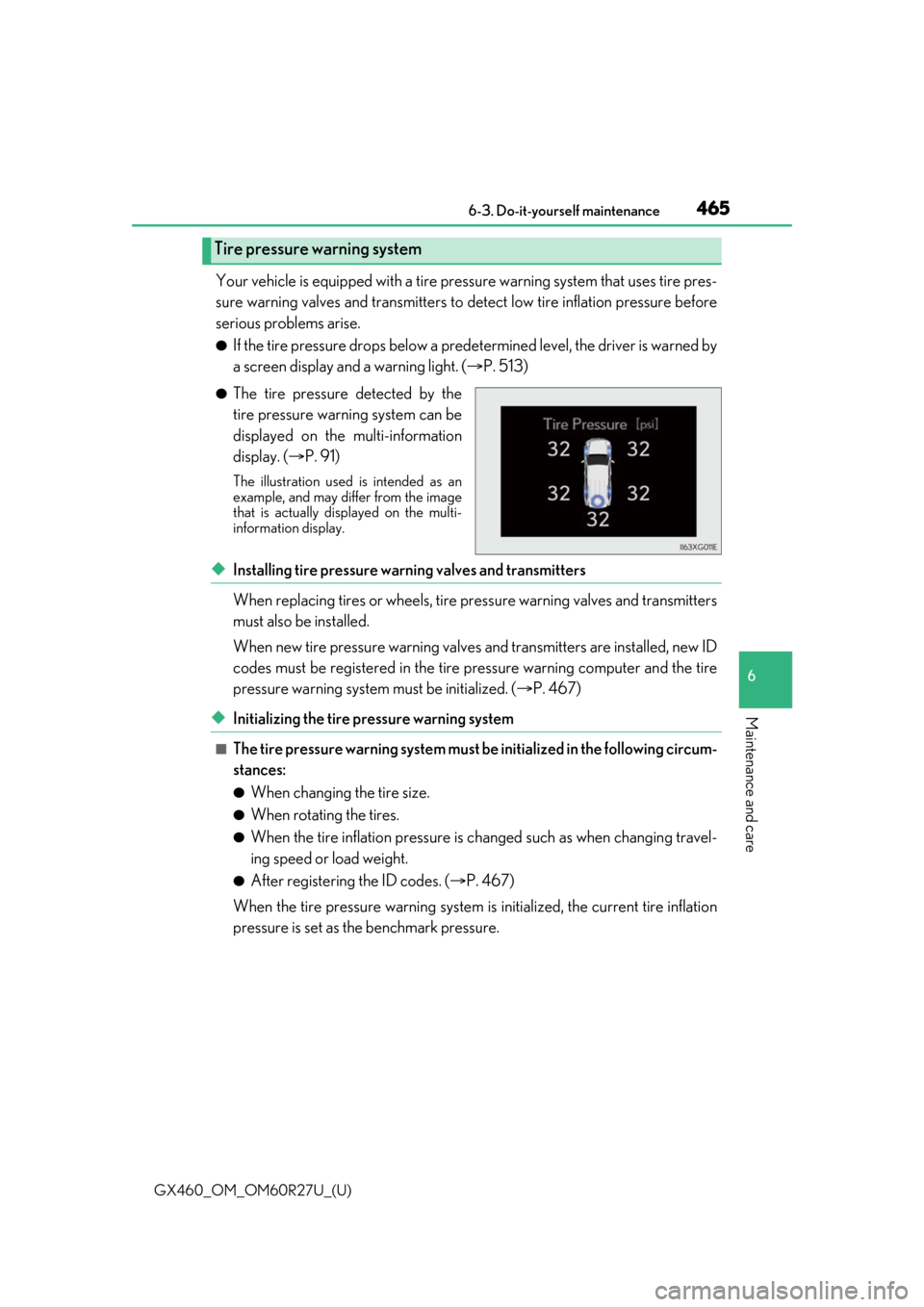
GX460_OM_OM60R27U_(U)
4656-3. Do-it-yourself maintenance
6
Maintenance and care
Your vehicle is equipped with a tire pressure warning system that uses tire pres-
sure warning valves and transmitters to detect low tire inflation pressure before
serious problems arise.
●If the tire pressure drops below a predet ermined level, the driver is warned by
a screen display and a warning light. ( P. 513)
●The tire pressure detected by the
tire pressure warning system can be
displayed on the multi-information
display. ( P. 91)
The illustration used is intended as an
example, and may differ from the image
that is actually disp layed on the multi-
information display.
◆Installing tire pressure warning valves and transmitters
When replacing tires or wheels, tire pr essure warning valves and transmitters
must also be installed.
When new tire pressure wa rning valves and transmitters are installed, new ID
codes must be registered in the tire pressure warning computer and the tire
pressure warning system must be initialized. ( P. 467)
◆Initializing the tire pressure warning system
■The tire pressure warning system must be initialized in the following circum-
stances:
●When changing the tire size.
●When rotating the tires.
●When the tire inflation pressure is changed such as when changing travel-
ing speed or load weight.
●After registering the ID codes. ( P. 467)
When the tire pressure warning system is initialized, the current tire inflation
pressure is set as the benchmark pressure.
Tire pressure warning system
Page 466 of 620
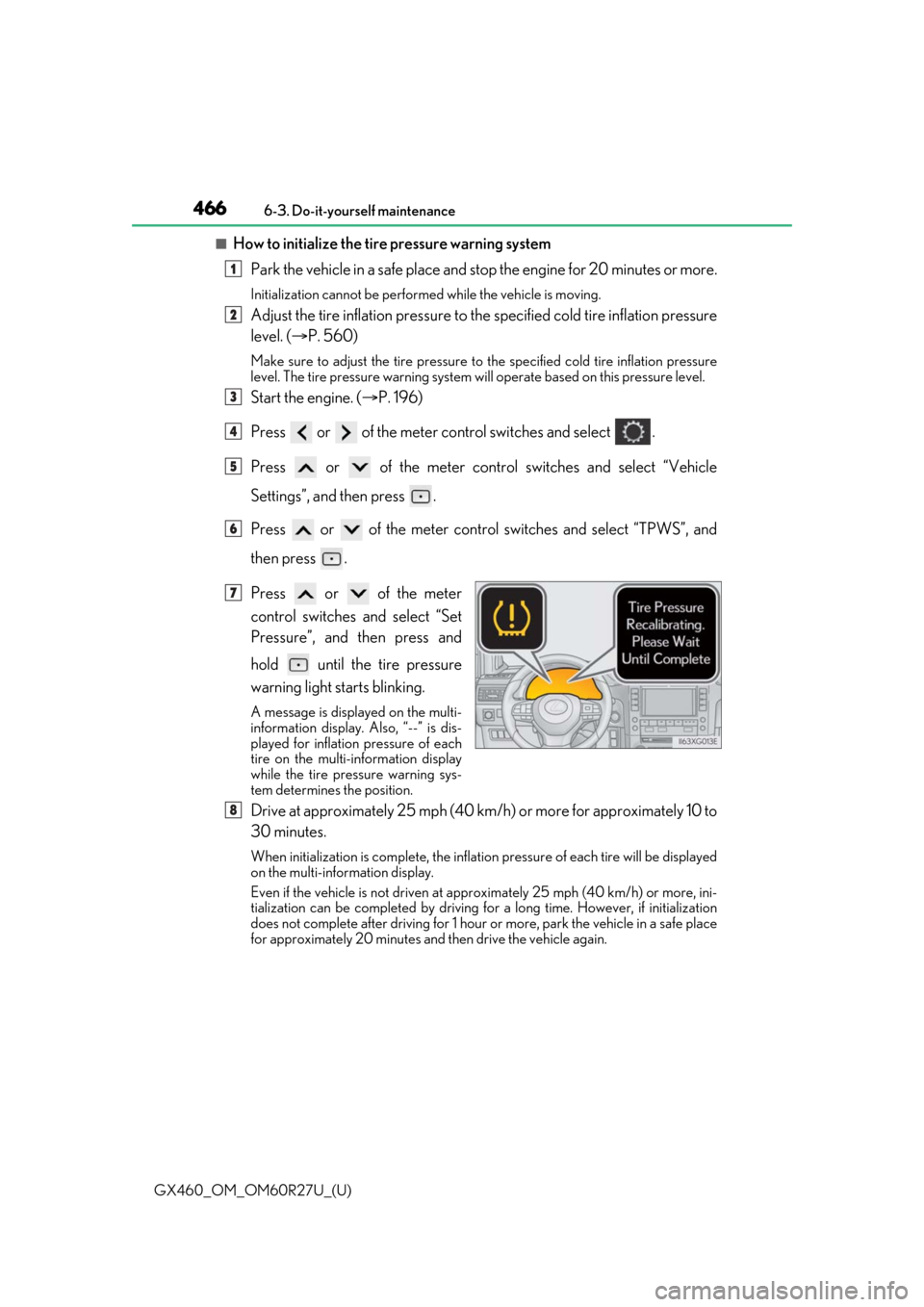
466
GX460_OM_OM60R27U_(U)6-3. Do-it-yourself maintenance
■How to initialize the tire pressure warning system
Park the vehicle in a safe place and st op the engine for 20 minutes or more.
Initialization cannot be performed while the vehicle is moving.
Adjust the tire inflation pressure to th e specified cold tire inflation pressure
level. ( P. 560)
Make sure to adjust the tire pressure to the specified cold tire inflation pressure
level. The tire pressure warning system will operate based on this pressure level.
Start the engine. (P. 196)
Press or of the meter control switches and select .
Press or of the meter control switches and select “Vehicle
Settings”, and then press .
Press or of the meter control switches and select “TPWS”, and
then press .
Press or of the meter
control switches and select “Set
Pressure”, and then press and
hold until the tire pressure
warning light starts blinking.
A message is displayed on the multi-
information display. Also, “--” is dis-
played for inflation pressure of each
tire on the multi-information display
while the tire pressure warning sys-
tem determines the position.
Drive at approximately 25 mph (40 km /h) or more for approximately 10 to
30 minutes.
When initialization is comple te, the inflation pressure of each tire will be displayed
on the multi-information display.
Even if the vehicle is not driven at ap proximately 25 mph (40 km/h) or more, ini-
tialization can be co mpleted by driving for a long ti me. However, if initialization
does not complete after driving for 1 hour or more, park the vehicle in a safe place
for approximately 20 minutes and then drive the vehicle again.
1
2
3
4
5
6
7
8
Page 467 of 620
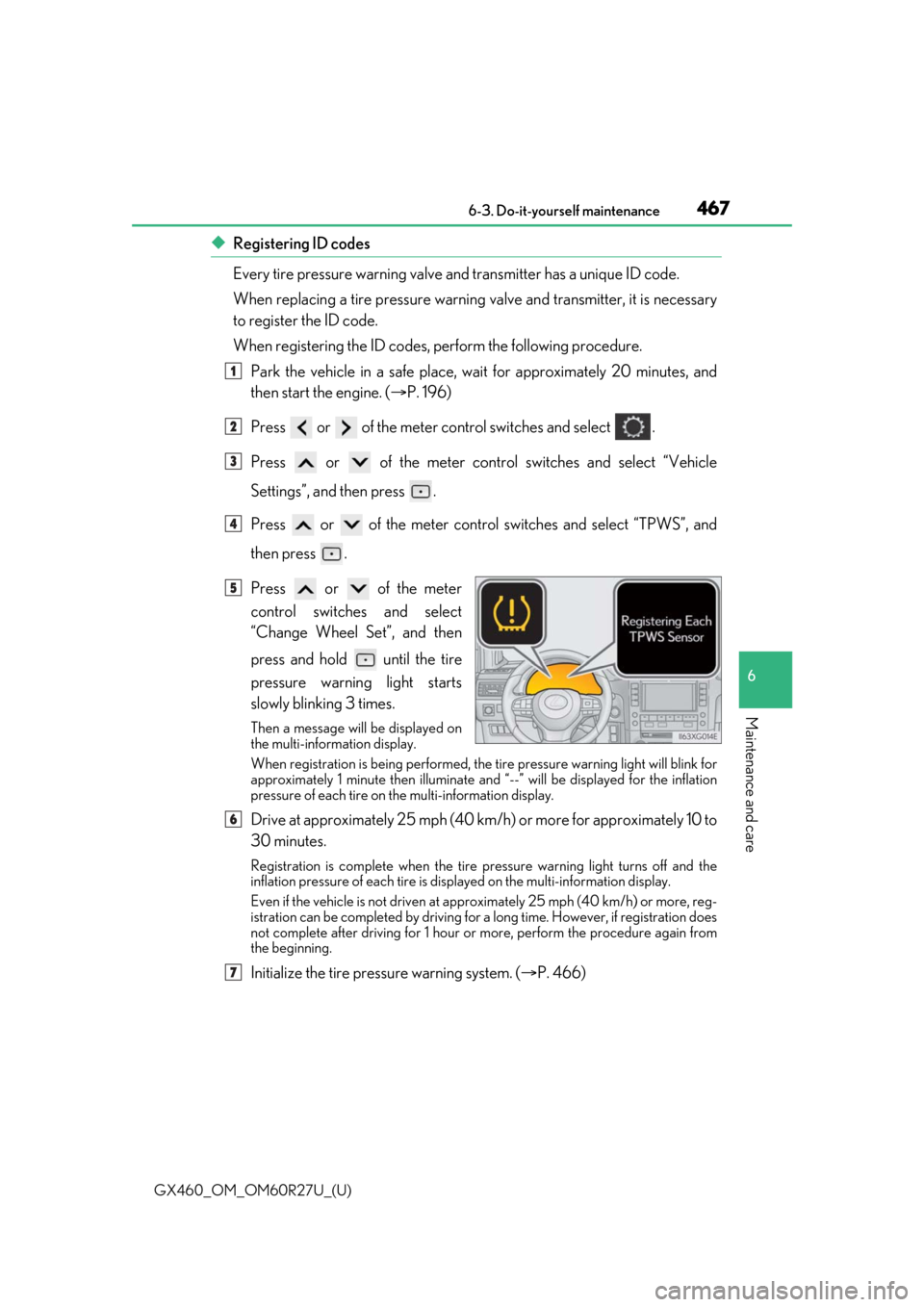
GX460_OM_OM60R27U_(U)
4676-3. Do-it-yourself maintenance
6
Maintenance and care
◆Registering ID codes
Every tire pressure warning valve and transmitter has a unique ID code.
When replacing a tire pressure warning valve and transmitter, it is necessary
to register the ID code.
When registering the ID codes, perform the following procedure.
Park the vehicle in a safe place, wait for approximately 20 minutes, and
then start the engine. ( P. 196)
Press or of the meter control switches and select .
Press or of the meter control switches and select “Vehicle
Settings”, and then press .
Press or of the meter control switches and select “TPWS”, and
then press .
Press or of the meter
control switches and select
“Change Wheel Set”, and then
press and hold until the tire
pressure warning light starts
slowly blinking 3 times.
Then a message will be displayed on
the multi-information display.
When registration is being performed, the tire pressure warning light will blink for
approximately 1 minute then illuminate and “--” will be displayed for the inflation
pressure of each tire on the multi-information display.
Drive at approximately 25 mph (40 km /h) or more for approximately 10 to
30 minutes.
Registration is complete when the tire pressure warning light turns off and the
inflation pressure of each tire is displayed on the multi-information display.
Even if the vehicle is not driven at approxim ately 25 mph (40 km/h) or more, reg-
istration can be completed by driving for a long time. However, if registration does
not complete after driving for 1 hour or more, perform the procedure again from
the beginning.
Initialize the tire pressure warning system. ( P. 466)
1
2
3
4
5
6
7
Page 468 of 620

468
GX460_OM_OM60R27U_(U)6-3. Do-it-yourself maintenance
■When to replace your vehicle’s tires
Tires should be replaced if:
●The treadwear indicators are showing on a tire.
●You have tire damage such as
cuts, splits, cracks deep enough to expose the fabric, and
bulges indicating internal damage
●A tire goes flat repeatedly or cannot be properly repaired due to the size or location of
a cut or other damage
If you are not sure, consult with your Lexus dealer.
■Replacing tires and wheels
If the ID code of the tire pressure warning valve and transmitter is not registered, the tire
pressure warning system will not work proper ly. After driving for about 20 minutes, the
tire pressure warning light blinks for 1 minu te and stays on to indicate a system malfunc-
tion.
■Tire life
Any tire over 6 years old must be checked by a qualified technician even if it has seldom
or never been used or damage is not obvious.
■Routine tire inflation pressure checks
The tire pressure warning syst em does not replace routine tire inflation pressure checks.
Make sure to check tire inflat ion pressure as part of your routine of daily vehicle checks.
■Maximum load of tire
Check that the number given by dividing the maximum load by 1.10 of the replacement
tire is greater than 1/2 of the Gross Axle We ight Ratings (GAWR) of either the front axle
or the rear axle, whichever is greater.
For the GAWR, see the Certification Label. For
the maximum load of the tire, see the load limit
at maximum cold tire inflation pressure men-
tioned on the sidewall of the tire. ( P. 565)
Page 469 of 620

GX460_OM_OM60R27U_(U)
4696-3. Do-it-yourself maintenance
6
Maintenance and care
■Tire types
●Summer tires
Summer tires are high-speed performance tires best suited to highway driving under
dry conditions. Since summer tires do not have the same traction performance as
snow tires, summer tires are inadequate for driving on snow-covered or icy roads. For
driving on snow-covered roads or icy road s, the use of snow tires is recommended.
When installing snow tires, be sure to replace all four tires.
●All season tires
All season tires are designed to provide better traction in snow and to be adequate for
driving in most winter conditions as well as for use year-round. All season tires, how-
ever, do not have adequate traction perfor mance compared with snow tires in heavy
or loose snow. Also, all season tires fall short in acceleration and handling perfor-
mance compared with summer tires in highway driving.
●Snow tires
For driving on snow-covered roads or icy roads, we recommend using snow tires. If
you need snow tires, select ti res of the same size, construction and load capacity as the
originally installed tires. Since your vehicle has radial tires as original equipment, make
sure your snow tires also have radial cons truction. Do not install studded tires without
first checking local regulations for possible restrictions. Snow tires should be installed
on all wheels. ( P. 367)
Page 470 of 620

470
GX460_OM_OM60R27U_(U)6-3. Do-it-yourself maintenance
■If the tread on snow tires wears down below 0.16 in. (4 mm)
The effectiveness of the tire
s as snow tires is lost.
■Situations in which the tire pressure warning system may not operate properly
●In the following cases, the tire pressure warning system may not operate properly.
• If non-genuine Lexus wheels are used.
• A tire has been replaced with a tire that is not an OE (Original Equipment) tire.
• A tire has been replaced with a tire that is not of the specified size.
• Tire chains etc. are equipped.
• An auxiliary-supported run-flat tire is equipped.
• If a window tint that affects th e radio wave signals is installed.
• If there is a lot of snow or ice on the vehi cle, particularly around the wheels or wheel
housings.
• If the tire inflation pressure is extr emely higher than the specified level.
• If the spare tire is in a location subj ect to poor radio wave signal reception.
• If a large metallic object which can interfere with signal reception is put near the
spare tire.
• If tires not equipped with the tire pressure warning valves and transmitters are used.
• If the ID code on the tire pressure warning valves and transmitters is not registered
in the tire pressure warning computer.
●Performance may be affected in the following situations.
• Near a TV tower, electric power plant, gas station, radio station, large display, air-
port or other facility that generates st rong radio waves or electrical noise
• When carrying a portable radio, cellular phone, cordless phone or other wireless
communication device
If tire position information is not correctl y displayed due to the radio wave conditions,
the display may be corrected by driving and changing the radio wave conditions.
●When the vehicle is parked, the time taken for the warning to start or go off could be
extended.
●When tire inflation pressure declines rapidly for example when a tire has burst, the
warning may not function.